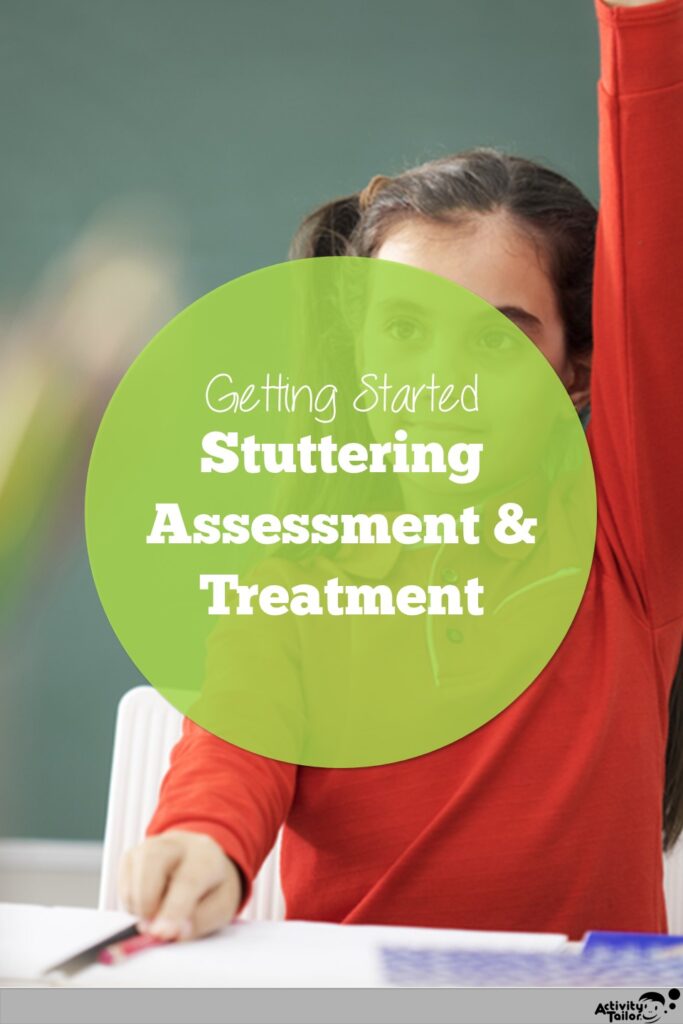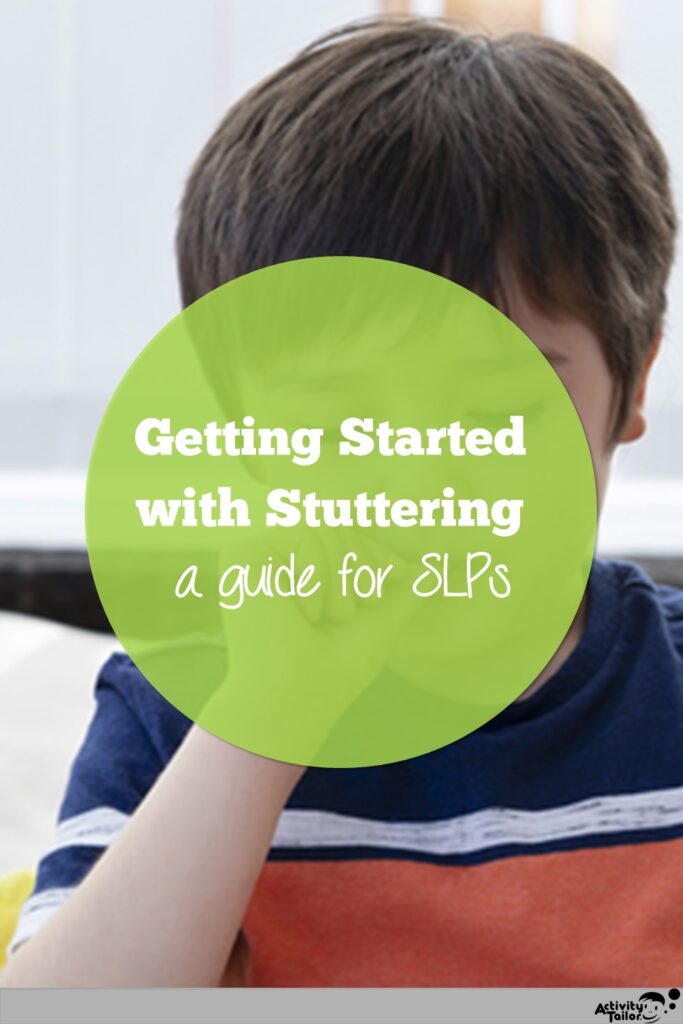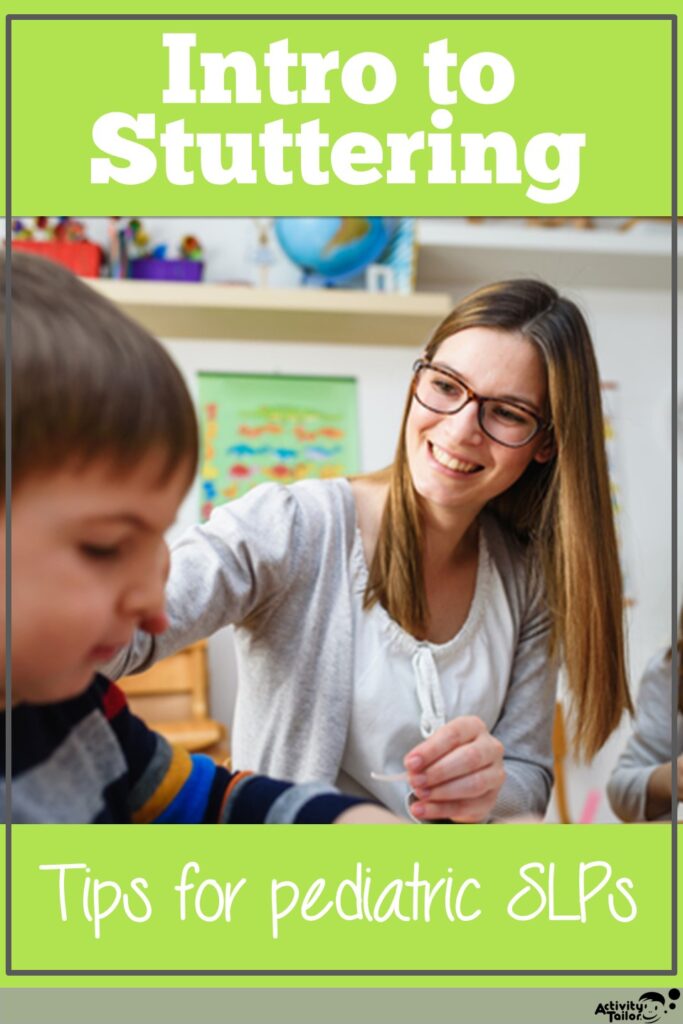Stuttering assessments and therapy can feel daunting, especially early on in your career as an SLP. They don’t have to be though! Continue reading for essential knowledge and hands-on resources to become more confident in treating the children with stuttering on your caseload.
What You Need to Know to Get Started with Stuttering Assessments and Therapy
Stuttering Assessment
A fluency evaluation is similar but also so different from other evaluations you will perform with children as an SLP.
Informal Evaluation
As with other types of evaluations, obtaining a thorough case history and making detailed observations are crucial pieces to assessing stuttering.
These informal portions of the fluency assessment provide invaluable information about stuttering behaviors, its onset, and severity. Understanding how stuttering impacts a student’s daily life is also important to ask about and observe in action.
Considering how aware a child is of his or her stuttering is important for determining appropriate interventions.
Formal Evaluation
The formal piece of a stuttering assessment includes a speech sample and standardized assessments.
Both of these pieces lead an SLP to assess the following attributes of the client’s stuttering:
- Frequency of disfluencies
- Type of disfluencies
- Length of disfluencies
- Presence of secondary behaviors
- Speech intelligibility
- Speech rate
After a stuttering assessment has been completed and a diagnosis has been given, it’s time to plan for therapy!
Stuttering Treatment
Speech Helpers
Educating students about their “Speech Helpers” is a key part of beginning treatment for stuttering.
Speech Helpers are the parts of the body that help a person communicate:
- Lips
- Mouth
- Ears
- Tongue
- Nose
- Lungs
- Vocal cords
- Teeth
- Diaphragm
When children have a solid understanding of what parts of their body they use to speak, it is easier for them to be aware of their disfluences and how to begin to communicate more easily through controlled breathing.
Myths about Stuttering
Even though stuttering is now known as a neurological condition, there are still many myths present about stuttering and stereotypes about the condition. These myths can make it difficult for students and parents to be motivated in therapy and essential carryover.
Examples include:
- Stuttering is caused by bad parenting.
- People only stutter because they are nervous.
- People who stutter can never have successful careers.
As the SLP, it’s important for you to help dispel these common myths for parents and students to help create a more positive mindset and encouraged attitudes.
Read more about what to say to refute these stuttering misconceptions from the National Stuttering Association.
Encourage students and families to look beyond these myths and see the limitless potential available!
Favorite Techniques and Resources for Stuttering Therapy
There are many great techniques and resources available for you to use in stuttering therapy, but there are a few tried and true options:
Stretchy Speech
Use Silly Putty as a visual demonstration of streeeeetchy speech.
Not only is it great fun to squish, but a slow, smooth pull helps students visualize the long strings of breath needed for easy speech.
On the contrary, an abrupt pull of the Silly Putty makes a snapping sound and a short, angular break– easily representing how disfluent speech feels and sounds.
Smooth and Bumpy Speech
Another favorite technique to use with students who stutter is called “Smooth and Bumpy Speech”.
Use toy cars, Lego strips, and pieces of tape to demonstrate the difference between bumpy and smooth speech. Have students drive the cars over both roads (the Lego strips and tape pieces) and discuss shifting “bumpy speech” to “smooth speech” by prolonging words and natural pauses.
Stuttering Modification
Modification techniques in stuttering are based on the Van Riper approach:
- Cancellation
- when a child learns to pause after stuttering and then say the word again using a preferred technique for easy speech
- Pull-out
- a child reduces tension during a stutter by “pulling out” of the disfluency
- Preparatory Sets
- when a child anticipates a word to be difficult and they continue to say the word by speaking slowly and calmly
Resources for Older Clients
This speech therapy fluency resource will take all the guesswork and stress out of knowing how to best support your 1st through 6th graders in therapy! Help students create a notebook with the various included worksheets and binder covers to educate others about one’s disfluent speech. It can be taken home, added to a classroom library, or shared with classmates for continued education.
Use this adventurous social story about stuttering with older elementary-aged students. Throughout the story, students learn facts about stuttering and are encouraged to share about the different emotions they might feel about their stuttering. This resource is available with a male or female narrator, allowing students to better relate with the main character.
This stuttering resource uses TED Talks that appeal to middle and high school students and is the perfect tool to help your students with speech fluency and stuttering challenges, social skills, and public speaking skills.
More Information
There’s always more to learn in our great field of speech-language pathology! Increase your knowledge of stuttering by reviewing the following sources:
SLP Stephen
SLP Stephen is a fellow SLP who also stutters. He uses Instagram and his website to help educate SLPs, parents, and individuals who stutter.
Check out his Fluency School Stuttering Toolbox for SLP-specific resources!
*I’m not an affiliate; I just truly believe in Stephen’s resources!
American Speech-Language-Hearing Association (ASHA)
ASHA is always a reputable source to use for gaining more information. The Overview of Fluency Disorders page contains a variety of helpful information from signs and symptoms to causes to current research for evidence-based practices.
Don’t let stuttering cases scare you! With these stuttering tips, you’re more than equipped to handle stuttering assessments and therapy whenever it comes your way.
You may also be interested in reading:
Why is early intervention important?
Expectations for Preschool Attention Spans








